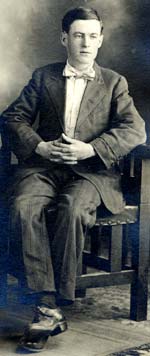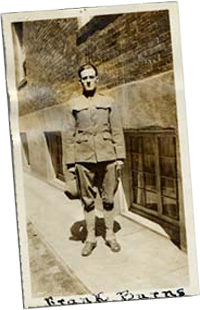 Corporal Frank Burns, the first Gilliam County resident to die in World War I. (OSA)
Corporal Frank Burns, the first Gilliam County resident to die in World War I. (OSA)
Not to Be Denied...
Frank Cassius Burns was a teenager when he moved from Ohio to the rolling hills of north-central Oregon with his family. But he quickly made friends and became part of the close-knit community of Condon in Gilliam County. After attending college at Mt. Angel, Burns returned to Condon to work as a clerk, and later treasurer, for a small local company.
Soon after the American declaration of war, Burns enlisted in the cavalry but was discharged because he was underweight. He returned to Condon resolved to gain the needed weight but once again was rejected. Undaunted, he kept trying and eventually was accepted, this time into the draft. Burns volunteered for active service with the infantry and within six weeks was under fire in France.
Observations of a Soldier
By early August 1918, his division was chasing the retreating Germans "so fast that it's hard to keep up with them." Burns lamented the destruction of the towns he passed through. Many of the towns were nothing but piles of rocks and rubbish. His ire for the enemy grew as he saw "beautiful homes with mirrors, carpets and pianos destroyed and churches with the alters hacked up and vestments and robes torn and destroyed." He was touched when marching through a village where just a few old people were left, who "...the minute they saw us came out crying and laughing for joy and they took hold of [us] to make sure they weren't dreaming."
View war destruction photographs.
But he clearly enjoyed his good fortune in finally making it into battle: "...I went through a little bit of Hell and I stood the grind fine and dandy." Burns' patriotism rose during one advance when he was in the first wave of an attack:
 Burns shows off the uniform he almost wasn't allowed to wear because of his light weight. (OSA)
Burns shows off the uniform he almost wasn't allowed to wear because of his light weight. (OSA)
Still, with all of the bravado, he wasn't afraid to share his emotions with his brother: "You know, Jim, when a fellow gets into the big noise [battle], he isn't half as nervous as when he is on his way up, maybe fifty or sixty miles behind. I thought I'd be scared stiff when I got into it but I wasn't, in fact I didn't have time. The worst strain is when you are in the reserve waiting to go in."
"I Am Not Going to Live"
Taking advantage of his light weight, Burns served as a runner or message courier in an era when more technologically advanced battlefield communications were unreliable. He also volunteered to help with wounded soldiers.
Burns' last fight came on August 29 when his battalion was engaged in support of a battle at Chateau Thierry. The front line troops were retreating through his battalion as the Germans were counter attacking. The commanding officer sent Burns and another soldier to capture a German machine gun that five men had been operating from behind a railroad fill. But shells were falling dangerously close. One struck a direct hit on the machine gun, killing three men and wounding Burns who was just 25 feet away. Although he remained conscious, the highly explosive shell shattered his hips. Aware of his mortal wounds, Burns confided to his friends: "I am not going to live." After they tried to encourage him, he replied "I know what I am talking about." Burns died at a nearby dressing station early the next morning.
A Fallen Hero Remembered
 Letterhead reflects the renamed American Legion post in Condon. (OSA, Oregon Defense Council Records, Personal Military Service Records, World War I, Box 2, Gilliam County, School District No. 25)
Letterhead reflects the renamed American Legion post in Condon. (OSA, Oregon Defense Council Records, Personal Military Service Records, World War I, Box 2, Gilliam County, School District No. 25)
In recognition of his bravery, Burns received the Distinguished Service Medal posthumously. He was eulogized by the Condon Globe newspaper as "Gilliam's first sacrifice in war for liberty and freedom of the entire world." The newspaper noted that his parents could at least have the consolation of knowing he was killed and not "taken to languish in a German prison camp." It added the question: "Killed in action...what more glorious epitaph can any man have?" Not long after his death, the local Condon chapter of the American Legion honored Burns by renaming itself "Frank Burns Post No. 25."
Notes
(Oregon State Defense Council Records, Personal Military Service Records, World War I, Box 2, Gilliam County, School District No. 25)